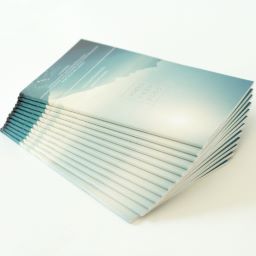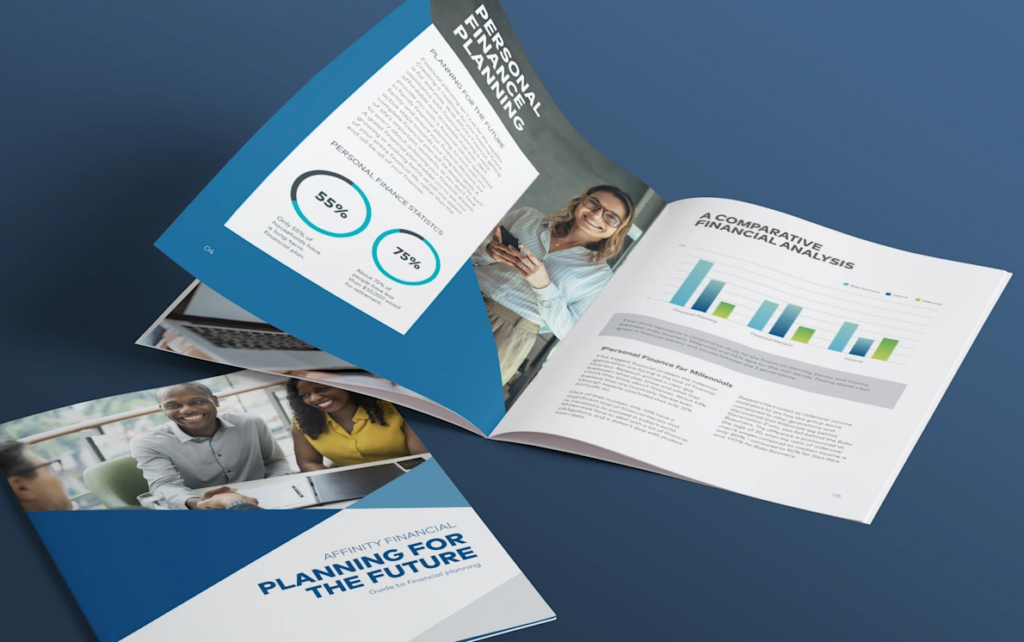What Makes Variable Content So Powerful in Booklet Printing?
What Makes Variable Content So Powerful in Booklet Printing?
Blog Article
The Crucial Overview to Understanding Booklet Printing Options and Techniques
The process of pamphlet printing entails several considerations that can greatly influence the end product. From picking the proper format and dimension to recognizing the subtleties of binding techniques, each choice plays an essential duty. Furthermore, elements such as paper stock and printing strategies additional affect the efficiency of the pamphlet. As one browses these choices, it becomes imperative to realize exactly how they interconnect and what that suggests for the general outcome.
Comprehending Booklet Layouts and Sizes
When taking into consideration brochure printing, recognizing the numerous styles and sizes offered is essential for accomplishing the wanted discussion. Booklets can be created in countless styles, consisting of saddle-stitched, spiral-bound, and perfect-bound, each offering unique benefits. Common dimensions vary from basic letter (8.5 x 11 inches) to smaller sized choices like A5 (5.8 x 8.3 inches), enabling flexibility based upon web content and target audience.Selecting the appropriate size can influence both the design and reader engagement. Larger sizes could match aesthetically driven material, while smaller styles may be extra portable and easy to use. Additionally, the number of web pages influences the selection of binding technique, as thicker pamphlets might require sturdier bindings. Eventually, recognizing these elements permits an extra tailored technique, guaranteeing that the final product lines up with the intended message and visual, boosting the overall effectiveness of the communication.
Selecting the Right Paper Stock

Binding Methods: Choices and Factors To Consider
When it involves binding methods for brochures, a number of choices are offered, each with distinct advantages. Saddle stitch binding offers a cost-effective solution for thinner brochures, while best binding strategies provide an even more refined try to find thicker publications. Wire-O binding stands apart for its longevity and simplicity of usage, making it excellent for documents that call for flexibility.
Saddle Stitch Binding
Saddle stitch binding provides a economical and practical service for assembling pamphlets, making it a popular selection among businesses and publishers. This binding approach entails folding sheets of paper in half and stapling them along the fold line, creating a well organized and cool appearance. Commonly ideal for pamphlets with a reduced page count, saddle sewing is excellent for publications, pamphlets, and training materials. The simpleness of this technique allows for quick manufacturing and is commonly favored for short runs or marketing things. Nonetheless, it is crucial to note that saddle stitch binding may not be suitable for thicker pamphlets, as the spinal column may not stand up under raised weight. In general, it remains a reliable alternative for lots of printing tasks.
Perfect Binding Strategies
Perfect binding is a commonly used strategy that provides a sleek and expert coating to magazines and booklets. This technique entails gluing the pages with each other at the spine utilizing a strong adhesive, enabling a clean edge and the capacity to hold a larger number of web pages compared to saddle stitching. Perfect binding is specifically suitable for thicker brochures, such as magazines and annual records, where a sturdy, flat back is desired. Additionally, it uses the alternative for a published cover that can be made to enhance aesthetic charm. Nonetheless, considerations such as page count, paper weight, and the planned use the pamphlet ought to be taken right into account, as they can influence sturdiness and total high quality.
Wire-O Binding Options
Wire-O binding, understood for its durability and versatility, supplies an outstanding alternative for pamphlets that need easy page transforming and a professional appearance. This binding technique utilizes a series of metal loops that hold pages firmly, permitting them to exist level when open. It is specifically ideal for magazines, handbooks, and presentations as a result of its robust nature. Wire-O binding is readily available in numerous shades and sizes, fitting different web page counts and thicknesses. Furthermore, it permits the incorporation of tabs and covers, enhancing the booklet's overall visual. Considerations for Wire-O binding include the selection of cable shade, the dimension of the loops, and the degree of modification desired, every one of which can profoundly influence the last item's appearance and functionality.
Digital vs. Offset Printing: Which Is Best for You?
When selecting a printing approach for booklets, recognizing the distinctions between electronic and offset printing is necessary. Digital printing utilizes modern innovation to create high-grade prints promptly and economically, making it ideal for brief runs or projects needing fast turnaround times. It permits customization, giving the ability to publish on-demand with minimal waste.In comparison, offset printing is a traditional technique that masters creating big amounts with consistent top quality. It involves transferring ink from a plate to a rubber covering, then to the paper, which causes right here precise details and vivid colors. Nevertheless, counter printing usually calls for longer configuration times and is extra affordable for larger volumes.Ultimately, the option in between electronic and counter printing depends upon job needs, budget, and desired quantity. For tiny, time-sensitive projects, electronic may be the most effective choice, while balanced out may be more effective for bigger, premium productions.

Creating Your Booklet: Tips and Ideal Practices
When creating a pamphlet, careful interest to design, typeface choice, and shade use can greatly improve its performance. A well-structured format guides the reader's eye, while suitable typefaces ensure readability and convey the preferred tone. In addition, efficient use color can stimulate emotions and highlight key information, making the overall layout extra impactful.
Selecting the Right Design
How can one successfully select the best design for a booklet? It is essential to assess the pamphlet's function and target audience. A clean, organized layout boosts readability and involvement. Making use of a grid system can help in aligning components continually, producing a professional appearance. Furthermore, including aesthetic power structure through differing dimensions and placements of pictures and message can direct the visitor's eye and emphasize crucial info. It is also crucial to leave sufficient white room, which avoids overcrowding and permits far better focus. Checking various layouts with mock-ups can offer understanding into exactly how the design performs in real-world situations, making certain that the last item satisfies both practical and visual needs. Practical Choosing Appropriate Fonts
An appropriate font style can substantially enhance the overall style of a pamphlet, enhancing the format and strengthening the web content's message. The option of typefaces ought to take into consideration readability, specifically for body message, as it assures the details comes to all viewers. Sans-serif typefaces are typically liked for digital formats, while serif fonts can lend a typical feel in printed products. It's suggested to restrict font options to two or 3 to keep aesthetic coherence. Additionally, font dimension plays a crucial function; headings must be unique but not frustrating, while body message must be comfortable for reading. When picking font styles, alignment with the brochure's style and target audience is essential for reliable communication and visual charm.
Effective Usage of Color
Shade acts as an effective device in booklet design, leading and shaping perceptions reader feelings. It can stimulate feelings of excitement, trust, or peace, depending upon the tones selected. Designers must take into consideration color concept concepts, guaranteeing that the selected scheme straightens with the booklet's message and target audience. Using warm shades like red and orange can develop urgency, while cooler tones like blue and green foster tranquility.Additionally, contrast plays a crucial function; corresponding shades can boost readability and aesthetic appeal. Consistency in color usage across web pages further strengthens brand name identification and communication. Inevitably, reliable shade application not just captures interest but also reinforces the booklet's objective, making it a vital element of successful design.
Finishing Touches: Coatings and Unique Results
While lots of think about the material and design of a booklet one of the most essential components, the completing touches, such as finishings and special results, play an essential duty in improving its overall appeal. Coatings can give defense and toughness, making sure that the brochure withstands damage. Matte finishes offer a sophisticated, non-reflective surface area, while glossy coatings can make shades show up even more attractive and vibrant. Special effects, like embossing or aluminum foil stamping, include a tactile measurement that can create an unforgettable impression. These strategies can highlight particular locations, accentuating crucial details or creating aesthetic interest. In addition, UV finishing can give a high-shine surface that elevates the total look.Together, these finishing touches not just enhance the brochure's visual but also interact professionalism and trust and focus to detail, eventually leaving a lasting influence on the viewers.
Expense Factors To Consider for Pamphlet Printing
Understanding the numerous expense factors to consider for booklet printing is necessary for companies and companies aiming to maximize their budget plans. Secret variables influencing costs include the option of ink, binding, and paper approaches. Higher high quality products, such as exceptional paper or specialized inks, generally boost the total expense. Additionally, the size and page count of the brochure play a Bonuses considerable role; larger brochures need more resources and time to produce.Another crucial factor to consider is the printing technique, whether digital or balanced out, as each has its own prices structure and suitability for different quantities. Organizations should likewise factor in style expenses, which can vary based upon intricacy and making use of specialist solutions. Eventually, shipping and handling charges can contribute to the overall, especially for huge orders. By evaluating these components, companies can make informed decisions that line up with their economic capabilities while attaining the preferred high quality in their printed her response materials.
Frequently Asked Inquiries
What Are the Ecological Effects of Brochure Printing?
The environmental impacts of pamphlet printing include deforestation from paper manufacturing, carbon exhausts from transport, and waste generation from discarded products - Booklet Printing. Sustainable methods, such as utilizing recycled paper and environmentally friendly inks, can mitigate these results
Exactly How Can I Make Certain Shade Accuracy in My Booklet?
To guarantee color precision in a pamphlet, one must utilize adjusted screens, use expert color accounts, conduct examination prints, and choose top quality printing solutions that use color matching and proofing alternatives for finest outcomes.
What Is the Common Turn-around Time for Brochure Printing?
The common turnaround time for brochure printing varies depending upon the intricacy and quantity - Booklet Printing. Usually, it varies from a few days to 2 weeks, influenced by aspects such as printing techniques and ending up needs
Are There Minimum Order Quantities for Pamphlet Printing?

Can I Publish Booklets in Multiple Languages?
Publishing pamphlets in several languages is feasible. Lots of printing solutions supply alternatives for multilingual or multilingual formats, allowing for efficient communication. Careful planning assurances that make components suit numerous languages without endangering readability or visual appeals. Furthermore, elements such as paper stock and printing techniques further influence the efficiency of the brochure. When thinking about brochure printing, recognizing the numerous layouts and dimensions offered is important for attaining the wanted discussion. When choosing a printing method for booklets, recognizing the distinctions between digital and counter printing is crucial. In addition, the dimension and page matter of the brochure play a considerable function; larger pamphlets need more sources and time to produce.Another crucial consideration is the printing technique, whether electronic or balanced out, as each has its own rates structure and suitability for various amounts. The environmental impacts of pamphlet printing include logging from paper manufacturing, carbon emissions from transport, and waste generation from disposed of materials.
Report this page